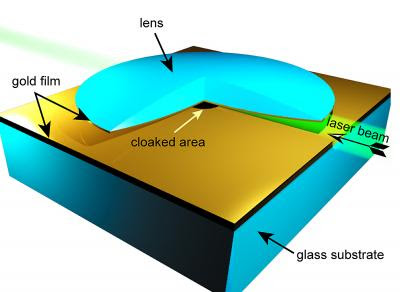A 'simpler' invisibility cloak

Still far from what you've seen on Star Trek, the development of technology to cloak objects--currently too small to see anyway--is heating up. Researchers at Purdue University report that they've created a new type of invisibility cloak that is simpler than previous designs, works for all colors of the visible spectrum, and can cloak larger objects than before.
The team of engineers used a specially "tapered optical waveguide" to cloak an area 100 times larger than the wavelengths of light shined by a laser into the device, an unprecedented achievement considering that previous experiments have been limited to cloaking regions only a few times larger than the wavelengths of visible light.
The key difference is the use of a waveguide, which is established technology used in communications and other commercial applications.
"Here, we showed that if a waveguide is tapered properly it acts like a sophisticated nanostructured material," said Vladimir Shalaev, Purdue University's Robert and Anne Burnett Professor of Electrical and Computer Engineering.
The researchers cloaked an object about 50 microns in diameter, or roughly the width of a human hair, in the center of the waveguide.
This approach has a leg up on metamaterials used in earlier cloaking experiments, since only a small portion of the new design contains little light-absorbing metal, meaning it could be used to cloak the full range of the visible light spectrum. Like metamaterials and unlike natural materials, the new waveguide can make the index of refraction vary from zero to one, which is needed for cloaking.
"Instead of being reflected as normally would happen, the light flows around the object and shows up on the other side, like water flowing around a stone," said Shalaev.
While the theoretical work for the design was led by Purdue, BAE Systems led the work to fabricate the device. It was formed by two gold-coated surfaces, one a curved lens and the other a flat sheet.
The research could lead to practical applications in "transformation optics," which may usher in a host of radical advances in addition to cloaking, such as powerful "hyperlenses" resulting in microscopes 10 times more powerful than today's and able to see objects as small as DNA. Computers and consumer electronics that use light instead of electronic signals to process information, advanced sensors, and more efficient solar collectors, are also within the realm of possibility.
Recent cloaking findings reported by researchers at other institutions have concentrated on a technique that camouflages features against a background.
The findings of the waveguide cloak are detailed in a research paper appearing May 29 in the journal Physical Review Letters. The paper was written by Igor I. Smolyaninov, a principal electronic engineer at BAE Systems in Washington, D.C.; Vera N. Smolyaninova, an assistant professor of physics at Towson University in Maryland; Alexander Kildishev, a principal research scientist at Purdue's Birck Nanotechnology Center; and Shalaev.
